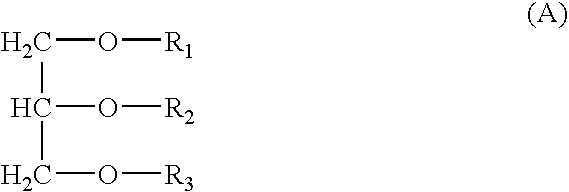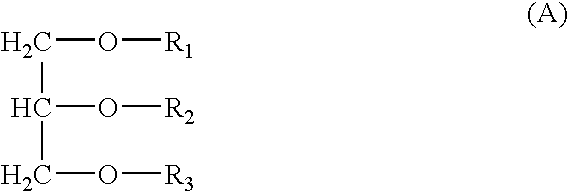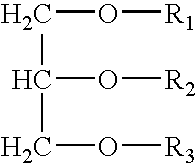Structured Lipid Compositions
a technology of structured lipids and compositions, applied in the field of shortenings and solid fats, can solve the problems of increasing the risk of heart attack, stroke, and high cholesterol, and achieve the effect of lowering the melting point of the mixtur
- Summary
- Abstract
- Description
- Claims
- Application Information
AI Technical Summary
Benefits of technology
Problems solved by technology
Method used
Image
Examples
example 1
[0050]A structured glycerol ester composition was prepared via a base catalyzed interesterification to form a triglyceride mixture primarily having glyceride esters with two long chain saturated fatty acids and one short chain fatty acids. To produce this structured lipid, a mixture of fatty acid constituents, as defined in Table 1 below, was randomly interesterfied in the presence of a catalytic amount of sodium methoxide (about 0.3%) with vigorous stirring at 125° C. for 20 minutes. The resulting crude mixture was fractionated through a wiped-film evaporator at about 0.1 Torr to remove the more volatile triacylglycerols that had only one long chain fatty acid. The residue from the evaporator was further distilled to produce a cream colored solid that contained about 84 weight percent triacylglycerols with two long chain saturated fatty acids and one short chain fatty acid. The composition of the resultant mixture (as measured by capillary high temperature GC of intact triacylglyce...
example 2
[0052]The structured lipid composition prepared in Example 1 was blended with various amounts of soybean oil (AC Humko) as defined in Table 3. The blends were then melted in a microwave oven to produce clear liquids. The samples were analyzed by pulsed NMR according to AOCS Official Method Cd 16b-93 to measure the equilibrium solid or solid fat content at different temperatures. The results are provided in Table 3. For comparison, two control oils were also tested having various levels of trans-unsaturated fatty acids: (1) soy spray 2 oil (SS2) (ADM) having about 42 to about 45 percent trans-unsaturated fatty acids and about 20 percent saturated fatty acids; and (2) LTB-1 oil (Kraft Foods) having about 78 percent soybean oil and about 22 percent partially hydrogenated cottonseed oil having less than about 8 percent trans-unsaturated fatty acids.
TABLE 3Solids Fat Content (SFC)Amount SGE, %SS2LTB1#1#2#3#4(High TFA(Low TFATemp, ° C.13%22%30%50%Control)Control)012.323.932.752.56524.5106...
example 3
[0054]The four test samples from Example 3 were warmed in a microwave oven at full power for sufficient time to produce clear liquids. Each liquid was allowed to cool without agitation at ambient temperatures (about 25° C.) and over the course of about 1 hour the ability of each sample to form a solid matrix was observed. The observations are provided in Table 4 below.
TABLE 4ObservationsSample 1Amount SGE, %Amount Oil, %Observation11387some solid suspended inliquid oil22278gel forms slowly33070gel forms slowly45050rapidly forming opaquegel
[0055]When the samples were fully equilibrated to ambient temperature (˜25° C.), samples 2-4 could be inverted with little or no liquid draining indicating their ability to function as a solid fat matrix at ambient temperatures.
PUM
 Login to View More
Login to View More Abstract
Description
Claims
Application Information
 Login to View More
Login to View More - R&D
- Intellectual Property
- Life Sciences
- Materials
- Tech Scout
- Unparalleled Data Quality
- Higher Quality Content
- 60% Fewer Hallucinations
Browse by: Latest US Patents, China's latest patents, Technical Efficacy Thesaurus, Application Domain, Technology Topic, Popular Technical Reports.
© 2025 PatSnap. All rights reserved.Legal|Privacy policy|Modern Slavery Act Transparency Statement|Sitemap|About US| Contact US: help@patsnap.com



